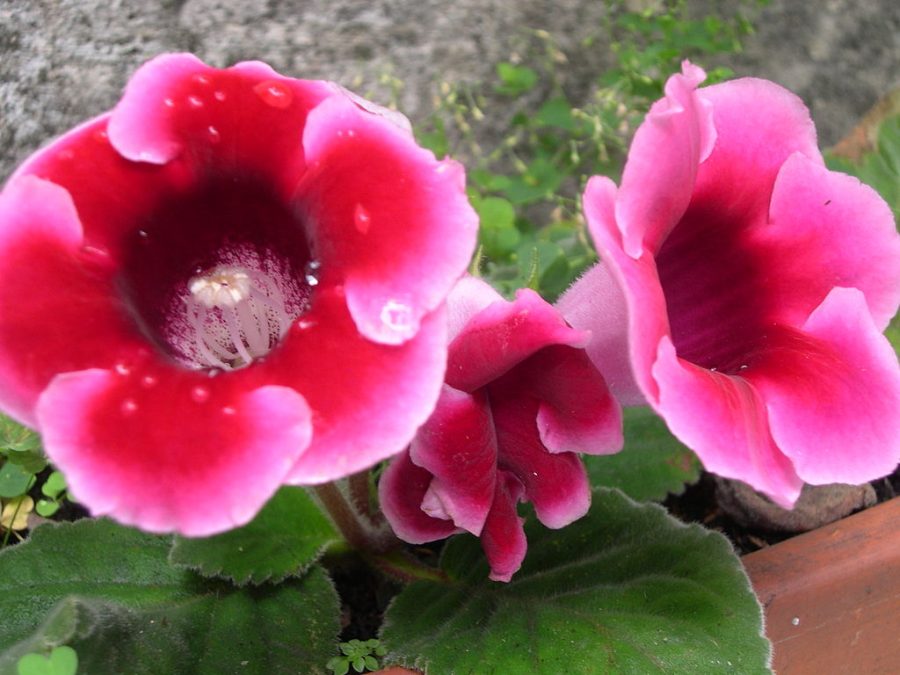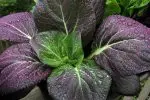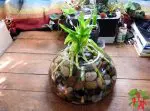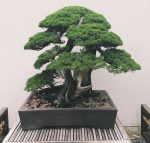This post contains affiliate links. If you buy something from one of our links we may earn a commission. Thanks
 Discover the secrets to Gloxinia Plant Care in our friendly guide! Uncover tips for a thriving, beautiful plant from blooming to dormancy. Get started now!
Discover the secrets to Gloxinia Plant Care in our friendly guide! Uncover tips for a thriving, beautiful plant from blooming to dormancy. Get started now!
To care for a Gloxinia Plant, place it in bright, indirect light and keep the soil consistently moist but not waterlogged. Provide high humidity and maintain a temperature range of 60-75°F (16-24°C). Fertilize with a balanced liquid fertilizer every two weeks during the growing season. Avoid getting water on the leaves to prevent rot.
Welcome to the wonderful world of Gloxinia Plant Care! If you’re looking for a stunning houseplant with velvety, vibrant flowers that’s sure to impress, you’ve come to the right place.
In this guide, we’ll share all the tips and tricks you need on how to care for a gloxinia plant. So, let’s dive in and get our green thumbs ready for some fun and rewarding gardening!
Gloxinia Plant Care: Tips and Tricks for a Healthy Plant
Discover the beauty and charm of Sinningia speciosa, commonly known as gloxinia, a popular houseplant native to Brazil.
In this comprehensive guide, we’ll cover everything you need to know about gloxinia plant care, including how to care for a gloxinia plant in various seasons and under different conditions.
Let’s dive into the world of gloxinia care and help your plant thrive!
Gloxinia Care Basics
Butterfly Gloxinia Tigrina Mix Flowering Bulb
Let’s kick off our Gloxinia Care Basics with some good vibes and essential knowledge!
Whether you’re a seasoned plant grower or a budding green thumb, we’ve got you covered.
In this section, we’ll explore the unique features of Sinningia speciosa and make sure you’re well-equipped to provide the best care for your beloved gloxinia.
So, let’s get started and bring some beautiful blooms into your life!
Getting to Know the Sinningia speciosa Plant
Ah, the beautiful Sinningia speciosa! This eye-catching plant is a tuberous member of the Gesneriaceae family and is native to Brazil.
Its large, velvety flowers come in a variety of vibrant colors, making it a popular choice for houseplant enthusiasts.
Similar to African violets in some ways, gloxinias do have their own unique care requirements.
Don’t worry; we’ll guide you through every step to ensure your plant thrives!
Common Names and Classification: Gloxinias and More
Now, let’s talk about names. While Sinningia speciosa is the plant’s scientific name, it’s more commonly known as gloxinia.
But it’s important to note that the name “gloxinia” is now technically incorrect, as the plant was reclassified from the Gloxinia genus to Sinningia.
Sometimes, you’ll also hear it referred to as florist’s gloxinia or Brazilian gloxinia.
So, when you’re searching for information or shopping for a new plant, just remember that these different names all refer to the same gorgeous plant we’re here to help you care for!
Gloxinia Light Requirements
Ready to brighten up your day with Gloxinia Light Requirements? Providing the right amount of light is crucial for keeping your gloxinia happy and healthy.
In this section, we’ll dive into the ideal lighting conditions for your plant and how to achieve them indoors.
So, let’s shed some light on the subject and make sure your gloxinia basks in just the right amount of sunshine!
Finding the Sweet Spot: Ideal Lighting Conditions
Lighting is key when it comes to keeping your gloxinia cheerful and blooming.
These plants love bright, indirect light, which means they need exposure to sunlight but not directly under the sun’s harsh rays.
Too much direct sunlight can scorch their delicate leaves, while too little light can cause poor growth and fewer blooms.
So, the goal is to find that sweet spot where your gloxinia gets plenty of light without any damage.
Bringing the Light Indoors: Tips for Gloxinia Care
Now that we know what kind of light our gloxinia craves, how can we recreate those conditions indoors?
Here are some tips to provide the perfect lighting for your plant:
• Place your gloxinia near a bright window, preferably an east or west-facing one, where it can enjoy plenty of indirect sunlight.
• If your plant isn’t getting enough light, you can supplement with artificial lighting, such as fluorescent or LED grow lights. Just make sure to place them a safe distance away to avoid overheating your plant.
• Keep an eye on the seasons! As the days get shorter, you might need to adjust your plant’s location or add supplemental lighting to keep it happy.
• Pay attention to your gloxinia leaves. If they’re turning yellow or becoming pale, it might be a sign that your plant is getting too much direct sunlight.
• On the other hand, if the leaves are stretching or becoming leggy, it’s probably not getting enough light.
• By following these tips, you’ll ensure your gloxinia has the perfect indoor lighting setup to grow and bloom beautifully!
Gloxinia Water Requirements
Ready to quench your gloxinia’s thirst? Let’s dive into Gloxinia Water Requirements!
Just like any other plant, gloxinias need the right amount of water to grow and bloom beautifully.
But striking the perfect balance between too much and too little can be a bit of a challenge.
In this section, we’ll share the watering secrets to keep your gloxinia hydrated and healthy, ensuring it gets the moisture it needs without drowning in excess water.
So, grab your watering can, and let’s explore the world of gloxinia hydration!
Quenching the Thirst: How Often to Water Your Gloxinia Plant
Finding the right watering schedule for your gloxinia is key to its overall health. Here’s what you need to know:
Watering frequency: Generally, you should water your gloxinia when the top inch of soil feels dry to the touch. This can vary depending on factors like humidity, temperature, and the size of your pot, so always check the soil before watering.
Watering method: When watering your gloxinia, it’s best to water from the bottom to avoid getting the leaves wet. Fill a saucer or tray with water and let the pot soak up the moisture for about 30 minutes. Then, remove any excess water to prevent root rot.
Adjusting for seasons: During the growing season (spring and summer), your gloxinia will likely need more frequent watering. As it enters dormancy in winter, you can reduce the watering frequency, allowing the soil to become almost dry between waterings.
Reading the Signs: Overwatering and Underwatering
Your gloxinia may show signs if it’s getting too much or too little water. Here’s how to recognize the symptoms and adjust your watering accordingly:
Overwatering: Signs of overwatering include yellowing leaves, wilting, and root rot. If you notice these symptoms, cut back on watering and ensure your pot has proper drainage.
Underwatering: If your gloxinia’s leaves become dry, curled, or brown at the edges, it may not be getting enough water. Check the soil moisture more frequently, and water when the top inch is dry.
By understanding your gloxinia’s water requirements and adjusting your care accordingly, you’ll help your plant stay hydrated, happy, and blooming beautifully!
Gloxinia Blooming Season
Who’s ready for a burst of color? Let’s talk about Gloxinia Blooming Season!
One of the most rewarding aspects of gloxinia care is witnessing the stunning display of vibrant flowers when they’re in bloom.
In this section, we’ll discuss when these beauties usually bloom and share some helpful tips on how to encourage a healthy, long-lasting flowering season.
So, let’s get ready to enjoy a floral extravaganza with our gloxinias!
Mark Your Calendars: When Do Gloxinias Bloom?
Gloxinias typically bloom in late spring to early summer, showcasing their magnificent flowers for several weeks.
However, with proper care and attention, it’s possible to extend the blooming season or even encourage a second round of blooms later in the year.
So, mark your calendars and get ready to enjoy the spectacular show your gloxinia has in store!
Blooming Tips: Encouraging a Fabulous Floral Display
Want to help your gloxinia put on the best show possible? Here are some tips to encourage a healthy, bountiful blooming season:
Provide the right light:
As we discussed earlier, bright, indirect light is essential for healthy blooms. Make sure your gloxinia is getting enough light to encourage flowering.
Feed your plant:
Use a balanced, water-soluble fertilizer, diluted to half strength, every 2-4 weeks during the growing and blooming seasons.
This will provide the necessary nutrients for optimal blooming.
Maintain consistent moisture:
Gloxinias prefer evenly moist soil, so make sure you’re watering your plant regularly and not allowing the soil to dry out completely.
However, avoid overwatering, as this can lead to root rot and other issues.
Keep the temperature steady:
Gloxinias thrive in temperatures between 65-75°F (18-24°C).
Sudden temperature fluctuations can stress the plant and affect blooming, so try to maintain a consistent environment.
Deadhead spent blooms:
Remove any faded or spent flowers to encourage new blooms and maintain your plant’s energy for continued growth.
By following these tips, you’ll set the stage for a spectacular blooming season and a gorgeous, vibrant gloxinia plant!
Gloxinia Propagation
Are you ready to spread the love with Gloxinia Propagation? There’s nothing more exciting than turning one beautiful plant into many!
In this section, we’ll explore different methods of propagating your gloxinia, so you can share the joy with friends, and family, or simply expand your own collection.
So, let’s dive in and learn how to multiply your gloxinia’s beauty!
Let’s Multiply: Methods of Gloxinia Propagation
Ready to create more gloxinia plants? Here are the most common methods to propagate your gloxinia successfully:
Seed Propagation: Growing Gloxinias from Tiny Beginnings
Starting gloxinias from seeds can be a fun and rewarding experience.
You’ll need to sow the seeds in a well-draining, moist seedling mix and maintain a warm temperature, ideally around 70-75°F (21-24°C).
Cover the seeds lightly with soil, and keep the soil moist but not soggy. Patience is key, as it can take 2-4 weeks for the seeds to germinate.
Once the seedlings have developed a few sets of true leaves, you can transplant them into individual pots and watch them grow!
Florist’s Gloxinia Brocade Garden Flower Seed
Tuber Division: Sharing the Love with a Slice
Another way to propagate your gloxinia is by dividing the tuber. This method works best when the plant is dormant, typically in late winter or early spring.
Carefully remove the plant from its pot and gently clean the soil from the tuber.
Using a sharp, sterilized knife, slice the tuber into sections, making sure each piece has at least one growth eye (a small bump where new growth will emerge).
Allow the cut surfaces to dry for a few hours, then plant each section in a well-draining potting mix.
Keep the soil lightly moist, and in a few weeks, you should see new growth sprouting from the divided tubers!
Green Thumbs Unite: Tips for Successful Propagation
No matter which method you choose, here are some handy tips to increase your chances of successful gloxinia propagation:
• Sterilize your tools: Always use clean, sterilized tools when cutting or dividing tubers to minimize the risk of infection.
• Use the right soil: A well-draining, fertile potting mix is essential for successful gloxinia propagation. You can use a mix designed for African violets or create your own blend.
• Maintain proper temperature and humidity: Gloxinias thrive in warm, humid environments. Make sure to provide the right conditions for your new plants to grow strong and healthy.
• Be patient: Propagation can take time, so don’t worry if you don’t see immediate results. Give your new plants some time and love, and they’ll reward you with beautiful growth.
With these tips and techniques, you’ll be well on your way to propagating your gloxinia and sharing the beauty with others or expanding your own collection!
Gloxinia Care in Winter
Brrr, it’s getting chilly! Time to talk about Gloxinia Care in Winter.
As temperatures drop and days grow shorter, our beloved gloxinias need some extra attention to stay happy and healthy during their dormant period.
In this section, we’ll cover the essential winter care tips to help your plant rest and recharge, ensuring it’s ready to spring back into action when the warmer months arrive.
So, let’s get cozy and learn how to pamper our gloxinias during the colder season!
Time for a Nap: The Dormant Period
Gloxinias, unlike some other houseplants, go through a dormant period during the winter months.
This is when their growth slows down, and they take a much-needed rest before the next growing season.
The dormancy usually lasts for about 8-12 weeks, and during this time, your gloxinia’s leaves may yellow or even drop off completely.
Don’t worry; this is normal! It’s simply the plant’s way of conserving energy while it recharges for a fresh start come springtime.
Winter Care: Tending to Your Gloxinia During Dormancy
Now that we know why our gloxinias take a winter snooze, let’s discuss how to care for them during this dormant period:
Reduce watering:
As your gloxinia’s growth slows down, it’ll need less water. Gradually reduce your watering frequency, allowing the soil to become almost dry between waterings.
Be careful not to let the tuber dry out completely, though, or it might not recover.
Cool and dark:
Move your gloxinia to a cooler, darker spot, ideally with temperatures between 50-60°F (10-15°C). This will help signal to the plant that it’s time for a break.
Hold off on fertilizing:
Since your gloxinia isn’t actively growing during dormancy, it won’t need any extra nutrients. Hold off on fertilizing until new growth begins to appear in the spring.
Prune if needed:
If any leaves yellow or wither during dormancy, feel free to gently remove them. This will help keep your plant tidy and minimize the risk of disease.
By following these winter care tips, you’ll help your gloxinia rest and recharge during its dormant period, ensuring it’s ready to burst back to life with vibrant blooms and healthy growth when spring arrives!
Gloxinia Problems
Uh-oh! Is your gloxinia feeling under the weather? Let’s tackle Gloxinia Problems together.
Like all plants, gloxinias can sometimes face a few challenges, from pesky pests to common diseases.
But not to worry! In this section, we’ll discuss some of the most common issues your gloxinia might encounter and provide you with solutions to keep your plant happy and healthy.
So, let’s roll up our sleeves and help our gloxinias overcome any obstacles that come their way!
Pesky Problems: Common Pests and Diseases
Even the most well-cared-for gloxinias can sometimes face issues. Here’s a list of common pests and diseases that might affect your plant:
Aphids: These tiny, sap-sucking insects can cause yellowing leaves and stunted growth. They also produce a sticky substance called honeydew, which can lead to mold growth.
Spider mites: These tiny pests can cause leaves to become speckled, yellow, or dry. You might also see fine webbing on the plant.
Mealybugs: These small, white, cottony insects can cause stunted growth and leaf drop, as they feed on the plant’s sap.
Fungal diseases: Gloxinias can be susceptible to various fungal infections, such as root rot, crown rot, or powdery mildew.
Symptoms may include yellowing or wilting leaves, blackened stems, or a powdery white coating on the leaves.
A Helping Hand: Prevention and Treatment Options
Now that we know what might be bugging our gloxinias, let’s discuss how to prevent and treat these issues:
Keep it clean:
Regularly inspect your plant for signs of pests or disease, and remove any affected leaves or stems promptly.
Keeping your plant’s environment clean and free of debris can help prevent problems from taking hold.
Ensure proper care:
Many issues can be avoided by providing the right care, including appropriate watering, fertilization, and lighting.
A healthy plant is better equipped to fend off pests and diseases.
Use natural remedies:
For minor pest infestations, you can try using a gentle solution of water and dish soap to wash off the pests.
Neem oil or insecticidal soap can also be effective in controlling pests when used according to the label instructions.
Fungicides:
If your gloxinia is suffering from a fungal disease, you can use a fungicide specifically designed for houseplants.
Be sure to follow the package instructions for proper use.
Quarantine affected plants:
If one of your gloxinias is experiencing a pest or disease issue, keep it away from your other plants to prevent the problem from spreading.
By keeping a close eye on your gloxinias and following these prevention and treatment tips, you’ll be well on your way to maintaining a happy, healthy plant collection!
Is Gloxinia Perennial?
Are you wondering, “Is Gloxinia Perennial?” You’re not alone! This is a common question among plant enthusiasts, and the answer might surprise you.
In this section, we’ll explore the perennial nature of gloxinias and discuss how their tuberous roots contribute to their lifespan.
So, let’s dive in and uncover the secret to your gloxinia’s longevity, and learn how to enjoy their beauty year after year!
Plant Lifespans: Perennial vs. Annual Plants
Before we dive into gloxinias, let’s get a quick refresher on the difference between perennial and annual plants:
Perennial plants: These are plants that live for more than two years. They typically have a period of dormancy in colder months and return to active growth when conditions improve.
Annual plants: Annuals complete their entire life cycle – from germination to producing seeds – within a single growing season. Once they’ve set seeds, they die and won’t return the following year.
Going the Distance: Gloxinia’s Growth Habit and Lifespan
Now that we’ve covered the basics, let’s explore gloxinia’s growth habits and lifespan:
Growth habit: Gloxinia is a tuberous perennial, which means it grows from an underground tuber that stores energy for the plant. This tuber helps the plant survive through periods of dormancy and regrow when conditions are right.
Lifespan: Although gloxinia is considered a perennial, its lifespan can vary depending on the care it receives. With proper care, a gloxinia plant can live for several years, producing stunning blooms each growing season.
Dormancy: Gloxinia plants typically have a dormant period during winter months when they appear to die back. However, the tuber remains alive underground, conserving energy for new growth in the spring.
By understanding the perennial nature of your gloxinia and its unique growth habits, you can appreciate its ability to provide beauty and enjoyment year after year!
Additional Gloxinia Care Tips
Just when you thought you had all the gloxinia care knowledge you needed, we’ve got even more tips to share!
In this section, we’ll cover Additional Gloxinia Care Tips that will help your plant truly thrive.
From fertilizer secrets to choosing the right container, we’ve got the inside scoop to help your gloxinia flourish.
So, let’s dive in and discover these extra nuggets of wisdom to make your plant care journey even more successful and enjoyable!
Feeding Time: Fertilizing Your Gloxinia Plant
To keep your gloxinia looking its best, it’s important to provide it with the right nutrients. Here’s what you need to know about fertilizing your plant:
Balanced fertilizer: Use a complete balanced water-soluble fertilizer with micronutrients diluted to half-strength.
Frequency: Fertilize your gloxinia every 4-6 weeks during the active growing season (spring through summer). There’s no need to fertilize during dormancy.
Avoid over-fertilizing: Excessive fertilizer can cause your plant to become leggy or develop weak, pale leaves.
Stick to the recommended schedule and dilution to prevent over-fertilizing.
Snip, Snip: Pruning and Maintenance
Regular pruning and maintenance can help your gloxinia stay healthy and look its best. Here’s what to do:
Remove spent blooms: As flowers fade, gently pinch or snip them off at the base of the stem to encourage more blooms and maintain a tidy appearance.
Trim yellowing leaves: If leaves start to yellow or wilt, remove them to keep your plant looking fresh and minimize the risk of disease.
Prune during dormancy: As your plant enters its dormant period, you may need to prune back any remaining foliage to help it conserve energy for the next growing season.
The Perfect Home: Choosing the Right Pot and Soil
Selecting the right pot and soil is crucial for your gloxinia’s health and happiness. Here’s what to consider:
Drainage: Choose a pot with drainage holes to prevent waterlogged soil, which can lead to root rot. A well-draining potting mix is also essential – you can use a mix designed for African violets or create your own blend.
Pot size: Select a pot that’s slightly larger than your gloxinia’s root system, giving it room to grow without becoming root-bound. However, avoid pots that are too large, as excess soil can retain moisture and lead to root problems.
Material: Pots made from materials like terracotta or ceramic can help regulate moisture levels, while plastic pots tend to retain water. Choose a material that works best for your plant’s needs and your personal preference.
By following these tips for fertilizing, pruning, and potting, you’ll help your gloxinia thrive, ensuring its beauty and longevity as a perennial plant in your collection!
Gloxinia Care FAQs
Caring for a Gloxinia plant indoors can be a rewarding experience if you’re attentive to its specific needs.
These beautiful flowering plants thrive in certain conditions and can make a stunning addition to your indoor garden.
While they may appear delicate, Gloxinia plants can be quite hardy when given the right care.
To help you get the best out of your Gloxinia, here are some frequently asked questions answered:
Q: How do you care for a gloxinia plant indoors?
A: Place your Gloxinia in bright, indirect light, and keep the soil consistently moist.
Maintain high humidity and a temperature range between 60-75°F.
Fertilize every two weeks during the growing season with a balanced liquid fertilizer.
Q: Does gloxinia need sunlight?
A: Gloxinia prefers bright, indirect sunlight. Direct sunlight can scorch the leaves, so it’s best to keep them in a spot where they can receive plenty of filtered light.
Q: How often do you water a gloxinia?
A: Keep the soil consistently moist, but not waterlogged. The frequency of watering can depend on the humidity and temperature of your home, so it’s advisable to check the soil regularly.
Q: How do you overwinter gloxinia?
A: To overwinter gloxinia, reduce watering and allow the plant to go dormant. Keep it in a cool, dark place until you see new growth in the spring, at which point you can resume regular care.
Remember, each Gloxinia plant may have its own unique needs, so it’s always good to observe your plant’s specific behaviors and adjust care accordingly.
Gloxinia Plant Care Final Thoughts
By following these gloxinia care guidelines, you’ll be well on your way to cultivating a stunning, healthy plant.
From understanding light and water requirements to promoting blooming and tackling potential problems, this guide will equip you with the knowledge you need to help your gloxinia thrive. Happy gardening!
Read more about the Benefits Of Keeping Indoor Plants
















